How Different Are Manometric, Gravimetric, and Automated Volumetric BMP Results?
Abstract
:1. Introduction
2. Materials and Methods
2.1. General Setup of BMP Experiments
2.2. Manual BMP Measurement
- Measure the headspace pressure and note the chamber temperature;
- Collect biogas sample for gas composition;
- Vent the headspace and measure the new headspace pressure;
- Weigh the bottle; and
- Mix the bottle contents by manual swirling for 5 s;
- Mix the bottle contents by manually swirling for 5 s;
- Measure the headspace pressure and note the chamber temperature;
- Collect biogas sample for gas composition;
- Release pressure and measure the new headspace pressure; and
- Weigh the bottle.
2.3. AMPTS II Measurements
2.4. Analytical Methods
2.5. Data Analysis
3. Results and Discussion
3.1. Comparison of Measurement Methods
3.2. Comparison of Mixing Modes
3.3. Methane Production Rate
3.4. Implications
4. Conclusions
- Differences among manometric and gravimetric methods exist, but for these experimental conditions (especially headspace volume), they are small (<5% difference between means).
- Low variability among methods and reasonable apparent degradability (≥80%) confirm that all three methods can be reasonably accurate.
- Measurement method differences clearly do contribute to variability among laboratories [6]. However, the (generally) larger differences observed in round robin tests suggests that other sources of error are more important.
- Given the narrow window for validation based on cellulose BMP and associated RSD, even small differences can be important. In this study, only gravimetric results could be validated based on current criteria.
- Higher BMP does not always mean more accurate BMP. The mixing comparison suggests that mixing after biogas measurements might underestimate CH4 production from blanks and so overestimate BMP.
- Kinetic information is, to some degree, dependent on the measurement method.
Supplementary Materials
Author Contributions
Funding
Acknowledgments
Conflicts of Interest
References
- Scarlat, N.; Dallemand, J.F.; Fahl, F. Biogas: Developments and perspectives in Europe. Renew. Energy 2018, 129, 457–472. [Google Scholar] [CrossRef]
- Koch, K.; Hafner, S.D.; Weinrich, S.; Astals, S.; Holliger, C. Power and Limitations of Biochemical Methane Potential (BMP) Tests. Front. Energy Res. 2020, 8, 1–4. [Google Scholar] [CrossRef]
- Angelidaki, I.; Alves, M.; Bolzonella, D.; Borzacconi, L.; Campos, J.L.; Guwy, A.J.; Kalyuzhnyi, S.; Jenicek, P.; Van Lier, J.B. Defining the biomethane potential (BMP) of solid organic wastes and energy crops: A proposed protocol for batch assays. Water Sci. Technol. 2009, 59, 927–934. [Google Scholar] [CrossRef] [PubMed] [Green Version]
- Owens, J.M.; Chynoweth, D.P. Biochemical Methane Potential of Municipal Solid Waste (MSW) components. Water Sci. Technol. 1993, 27, 1–14. [Google Scholar]
- Holliger, C.; Alves, M.; Andrade, D.; Angelidaki, I.; Astals, S.; Baier, U.; Bougrier, C.; Buffière, P.; Carballa, M.; De Wilde, V.; et al. Towards a standardization of biomethane potential tests. Water Sci. Technol. 2016, 74, 2515–2522. [Google Scholar] [CrossRef]
- Hafner, S.D.; Fruteau de Laclos, H.; Koch, K.; Holliger, C. Improving Inter-Laboratory Reproducibility in Measurement of Biochemical Methane Potential (BMP). Water 2020, 12, 1752. [Google Scholar] [CrossRef]
- Jingura, R.M.; Kamusoko, R. Methods for determination of biomethane potential of feedstocks: A review. Biofuel Res. J. 2017, 4, 573–586. [Google Scholar] [CrossRef]
- Raposo, F.; Fernández-Cegrí, V.; de la Rubia, M.A.; Borja, R.; Béline, F.; Cavinato, C.; Demirer, G.; Fernández, B.; Fernández-Polanco, M.; Frigon, J.C.; et al. Biochemical methane potential (BMP) of solid organic substrates: Evaluation of anaerobic biodegradability using data from an international interlaboratory study. J. Chem. Technol. Biotechnol. 2011, 86, 1088–1098. [Google Scholar] [CrossRef]
- Cresson, R.; Pommier, S.; Beline, F.; Bouchez, T.; Bougrier, C.; Buffière, P.; Pauss, A.; Pouech, P.; Preys, S.; Ribeiro, T. Results from a French Inter-Laboratory Campaign on the Biological Methane Potential of Solid Substrates. 2015. Available online: https://hal.archives-ouvertes.fr/hal-01947463/ (accessed on 22 April 2020).
- Filer, J.; Ding, H.H.; Chang, S. Biochemical Methane Potential (BMP) Assay Method for Anaerobic Digestion Research. Water 2019, 11, 921. [Google Scholar] [CrossRef] [Green Version]
- Pearse, L.F.; Hettiaratchi, J.P.; Kumar, S.; Moreno-Andrade, I.; Buitrón, G. Towards developing a representative biochemical methane potential (BMP) assay for landfilled municipal solid waste–A review. Water Sci. Technol. 2018, 49, 312–324. [Google Scholar] [CrossRef]
- Raposo, F.; De La Rubia, M.A.; Fernández-Cegrí, V.; Borja, R. Anaerobic digestion of solid organic substrates in batch mode: An overview relating to methane yields and experimental procedures. Renew. Sustain. Energy Rev. 2012, 16, 861–877. [Google Scholar] [CrossRef]
- Rozzi, A.; Remigi, E. Methods of assessing microbial activity and inhibition under anaerobic conditions: A literature review. Rev. Environ. Sci. Biotechnol. 2004, 3, 93–115. [Google Scholar] [CrossRef]
- VDI 4630. Fermentation of Organic Materials: Characterisation of the Substrate, Sampling, Collection of Material Data, Fermentation Tests; Verein Deutscher Ingenieure e.V.: Düsseldorf, Germany, 2016. [Google Scholar]
- Pereira, C.P.P.; Castañares, G.; Lier, J.B. Van An OxiTop® protocol for screening plant material for its biochemical methane potential (BMP). Water Sci. Technol. 2012, 66, 1416–1423. [Google Scholar] [CrossRef] [PubMed]
- Hafner, S.D.; Rennuit, C.; Triolo, J.M.; Richards, B.K. Validation of a simple gravimetric method for measuring biogas production in laboratory experiments. Biomass Bioenergy 2015, 83, 297–301. [Google Scholar] [CrossRef]
- Justesen, C.G.; Astals, S.; Mortensen, J.R.; Thorsen, R.; Koch, K.; Weinrich, S.; Triolo, J.M.; Hafner, S.D. Development and Validation of a Low-Cost Gas Density Method for Measuring Biochemical Methane Potential (BMP). Water 2019, 11, 2431. [Google Scholar] [CrossRef] [Green Version]
- Hafner, S.D.; Astals, S. Systematic error in manometric measurement of biochemical methane potential: Sources and solutions. Waste Manag. 2019, 91, 147–155. [Google Scholar] [CrossRef]
- Himanshu, H.; Voelklein, M.A.; Murphy, J.D.; Grant, J.; O’Kiely, P. Factors controlling headspace pressure in a manual manometric BMP method can be used to produce a methane output comparable to AMPTS. Bioresour. Technol. 2017, 238, 633–642. [Google Scholar] [CrossRef]
- Pauss, A.; Andre, G.; Perrier, M.; Guiot, S.R. Liquid-to-Gas mass transfer in anaerobic processes: Inevitable transfer limitations of methane and hydrogen in the biomethanation process. Appl. Environ. Microbiol. 1990, 56, 1636–1644. [Google Scholar] [CrossRef] [Green Version]
- Kaparaju, P.; Buendia, I.; Ellegaard, L.; Angelidakia, I. Effects of mixing on methane production during thermophilic anaerobic digestion of manure: Lab-scale and pilot-scale studies. Bioresour. Technol. 2008, 99, 4919–4928. [Google Scholar] [CrossRef]
- Wang, B.; Björn, A.; Strömberg, S.; Nges, I.A.; Nistor, M.; Liu, J. Evaluating the influences of mixing strategies on the Biochemical Methane Potential test. J. Environ. Manage. 2017, 185, 54–59. [Google Scholar] [CrossRef]
- Hafner, S.D.; Astals, S.; Buffiere, P.; Løjborg, N.; Holliger, C.; Koch, K.; Weinrich, S. Calculation of Methane Production from Manometric Measurements. Standard BMP Methods Document 202, Version 2.5. Available online: https://www.dbfz.de/en/BMP (accessed on 23 April 2020).
- Hafner, S.D.; Richards, B.K.; Astals, S.; Holliger, C.; Koch, K.; Weinrich, S. Calculation of Methane Production from Gravimetric Measurements. Standard BMP Methods Document 203, Version 1.0. Available online: https://www.dbfz.de/en/BMP (accessed on 19 April 2020).
- Bioprocess Control AB AMPTS II. Available online: http://www.bioprocesscontrol.com/products/ampts-ii/ (accessed on 19 April 2020).
- Gilcreas, F.W. Standard methods for the examination of water and waste water. Am. J. Public Health Nations Health 1966, 56, 387–388. [Google Scholar] [CrossRef] [PubMed]
- Hafner, S.D.; Astals, S.; Holliger, C.; Koch, K.; Weinrich, S. Calculation of Biochemical Methane Potential (BMP). Standard BMP Methods Document 200, Version 1.6. Available online: https://www.dbfz.de/en/BMP (accessed on 19 April 2020).
- R Core Team. A Language and Environment for Statistical Computing; R Foundation for Statistical Computing: Vienna, Austria, 2020. [Google Scholar]
- Holliger, C.; de Laclos, H.; Hafner, S.D.; Koch, K.; Weinrich, S.; Astals, S.; Alves, M.; Andrade, D.; Angelidaki, I.; Appels, L.; et al. Requirements for Measurement of Biochemical Methane Potential (BMP). Standard BMP Methods Document 100, Version 1.3. Available online: https://www.dbfz.de/en/BMP (accessed on 19 April 2020).
- Wang, B.; Strömberg, S.; Li, C.; Nges, I.A.; Nistor, M.; Deng, L.; Liu, J. Effects of substrate concentration on methane potential and degradation kinetics in batch anaerobic digestion. Bioresour. Technol. 2015, 194, 240–246. [Google Scholar] [CrossRef] [PubMed]
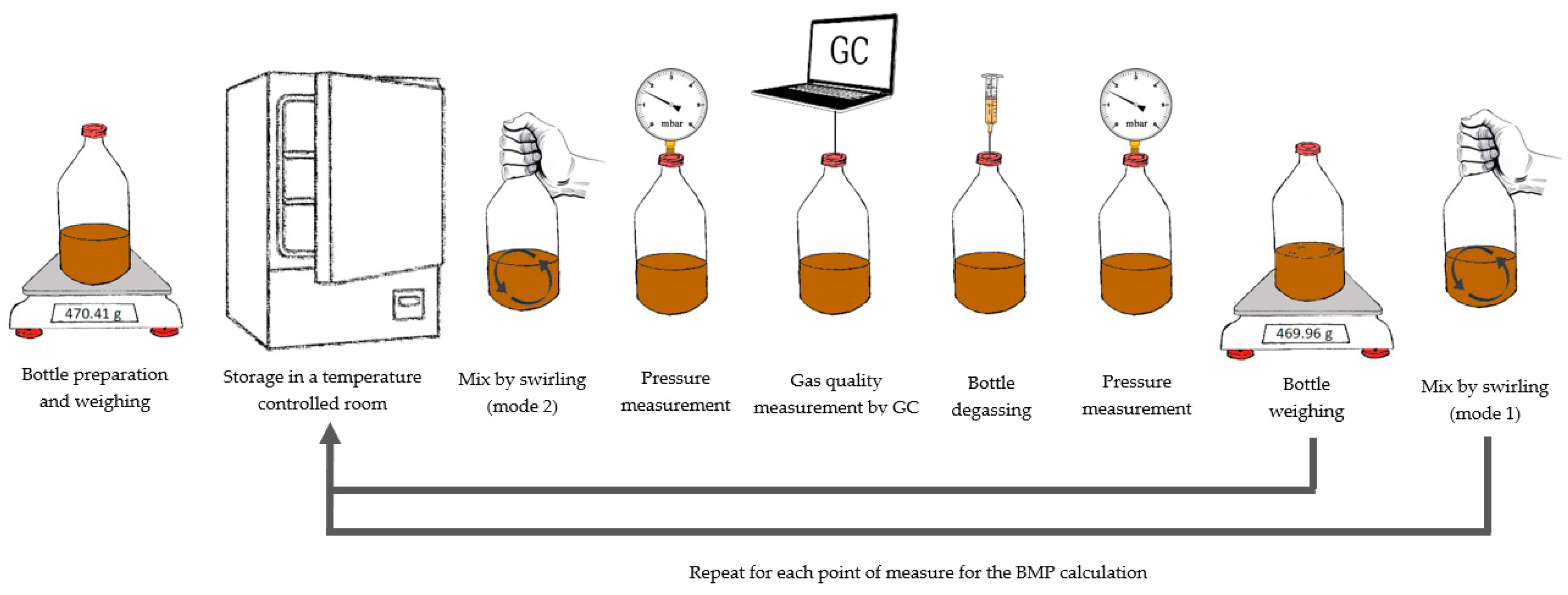
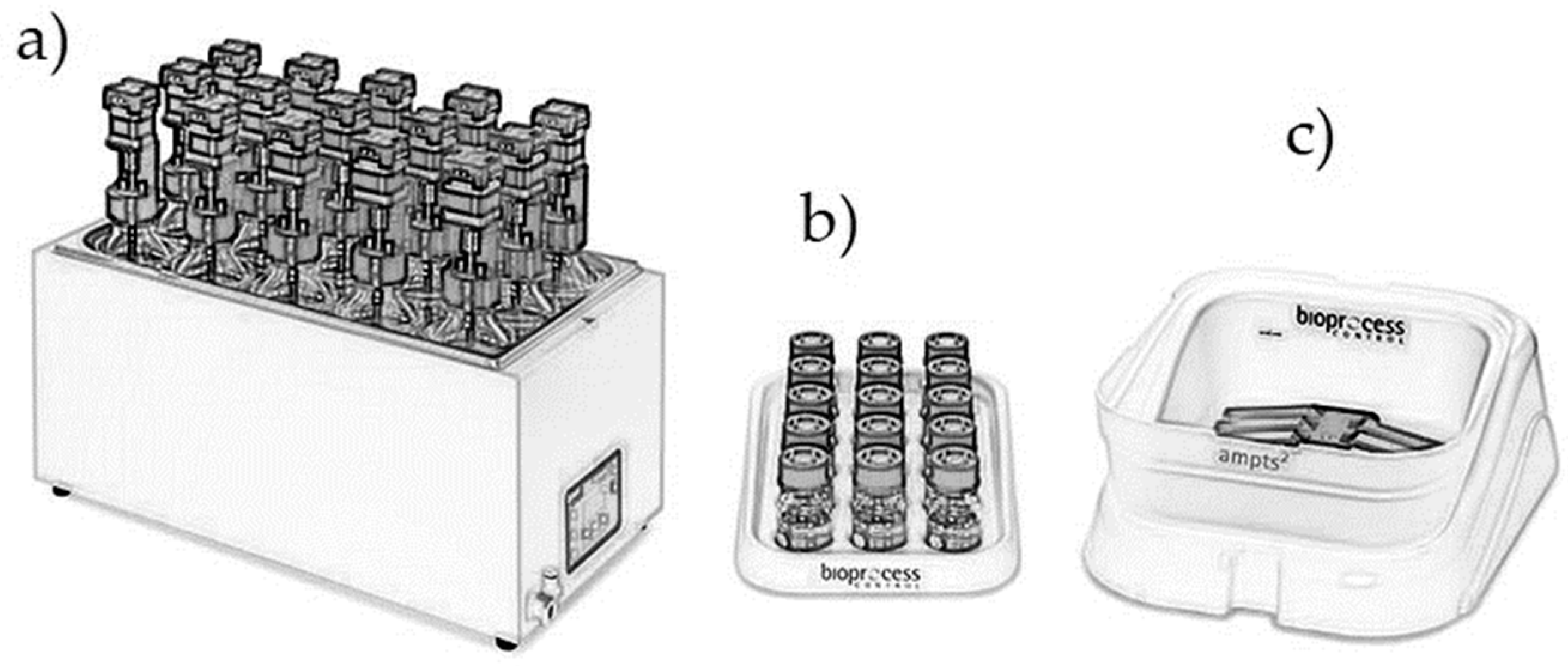
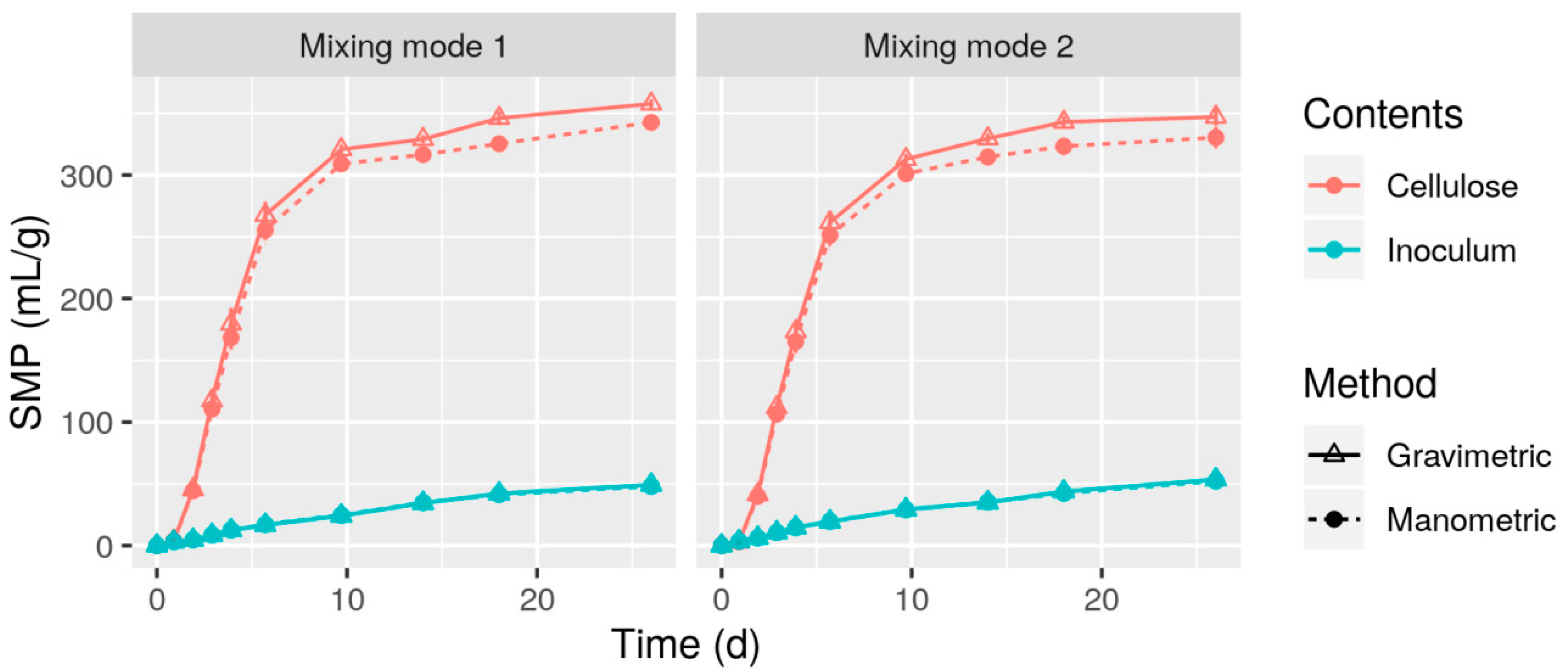
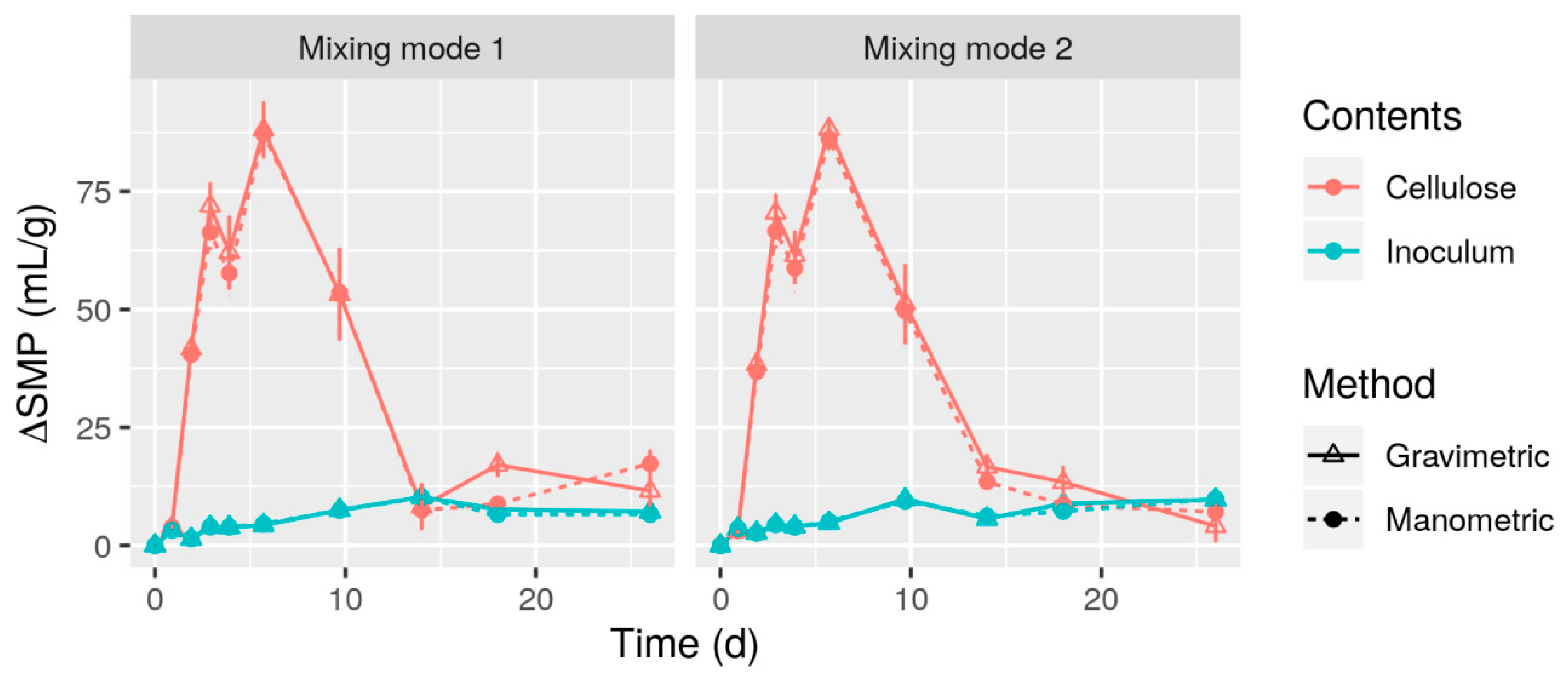
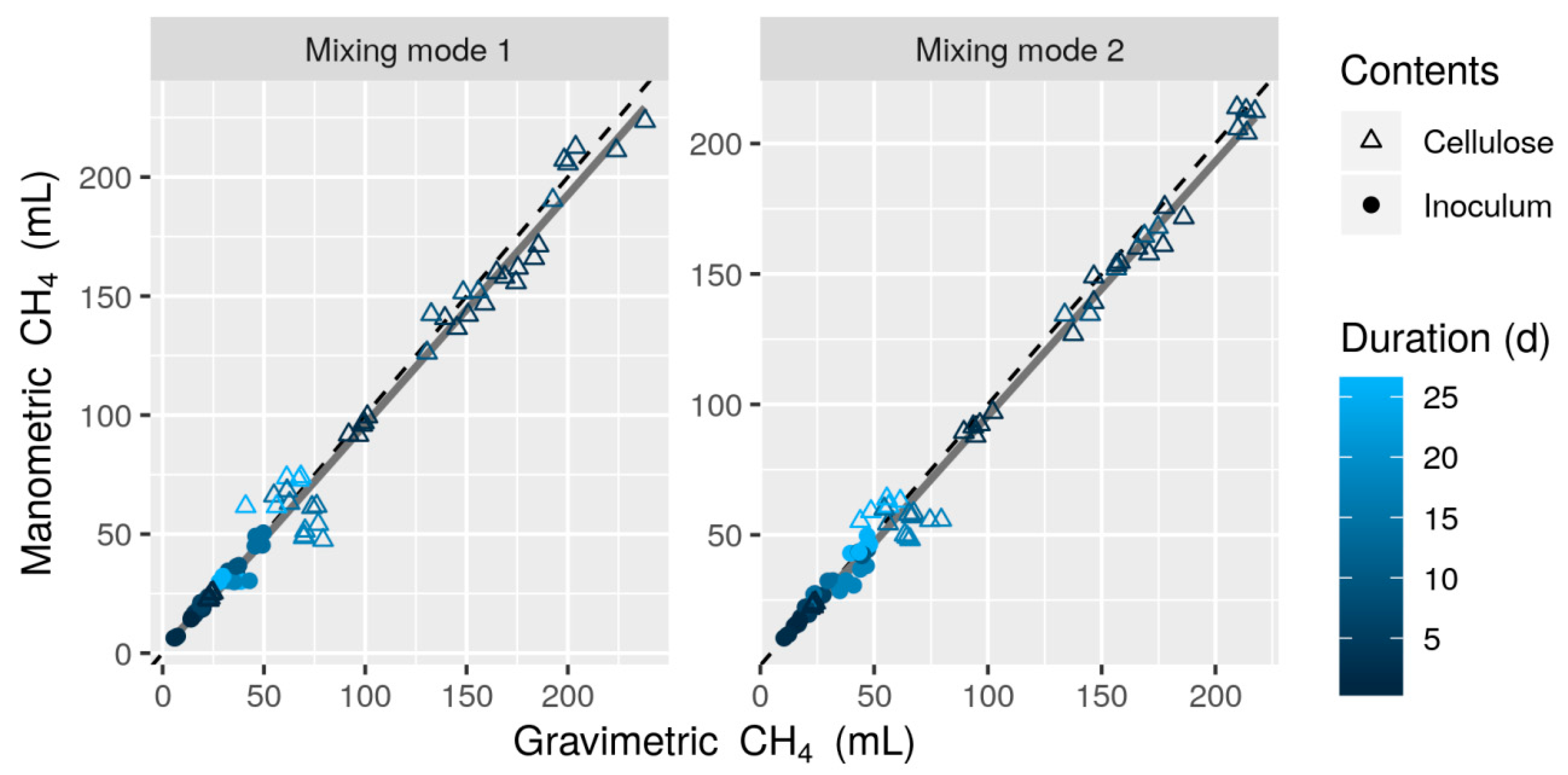
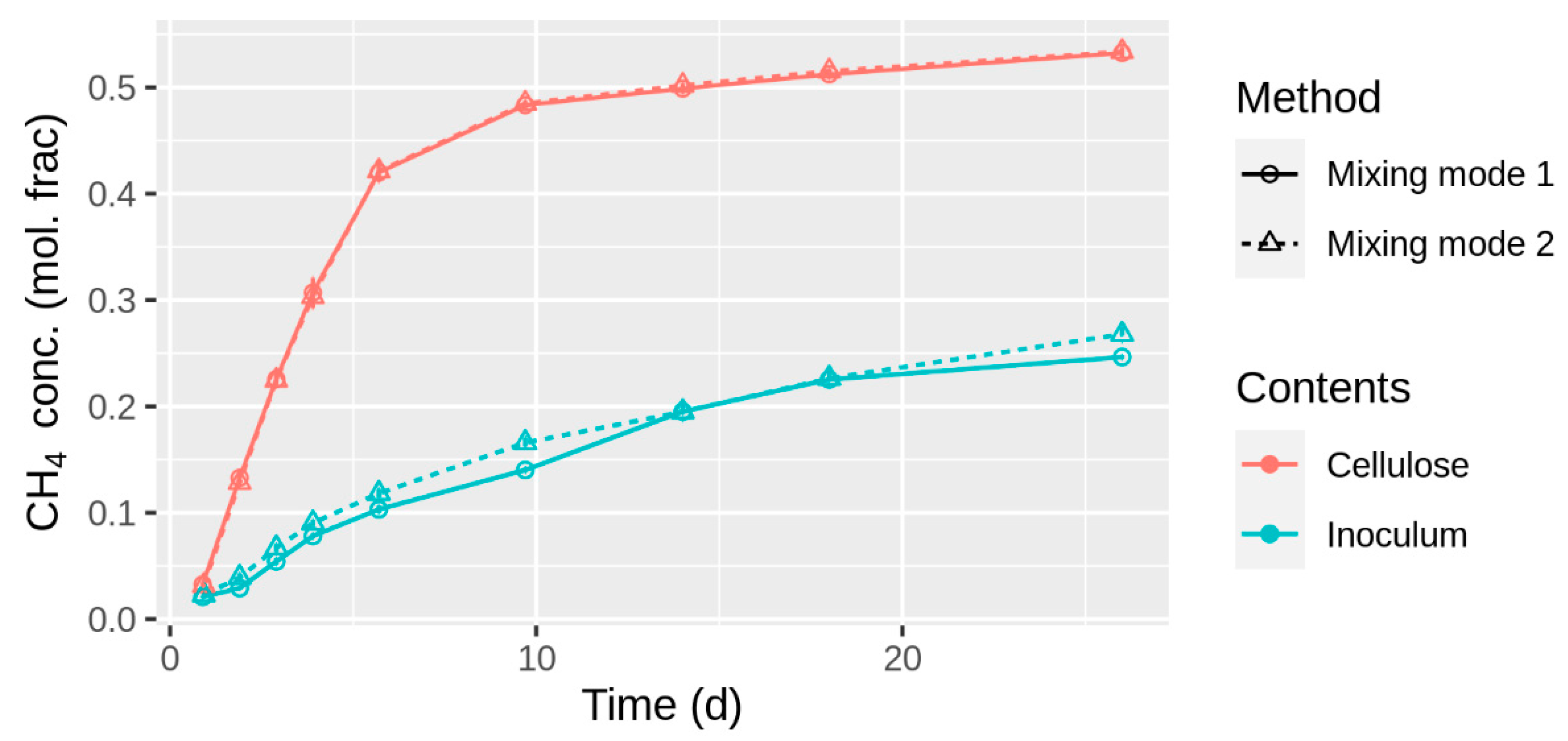
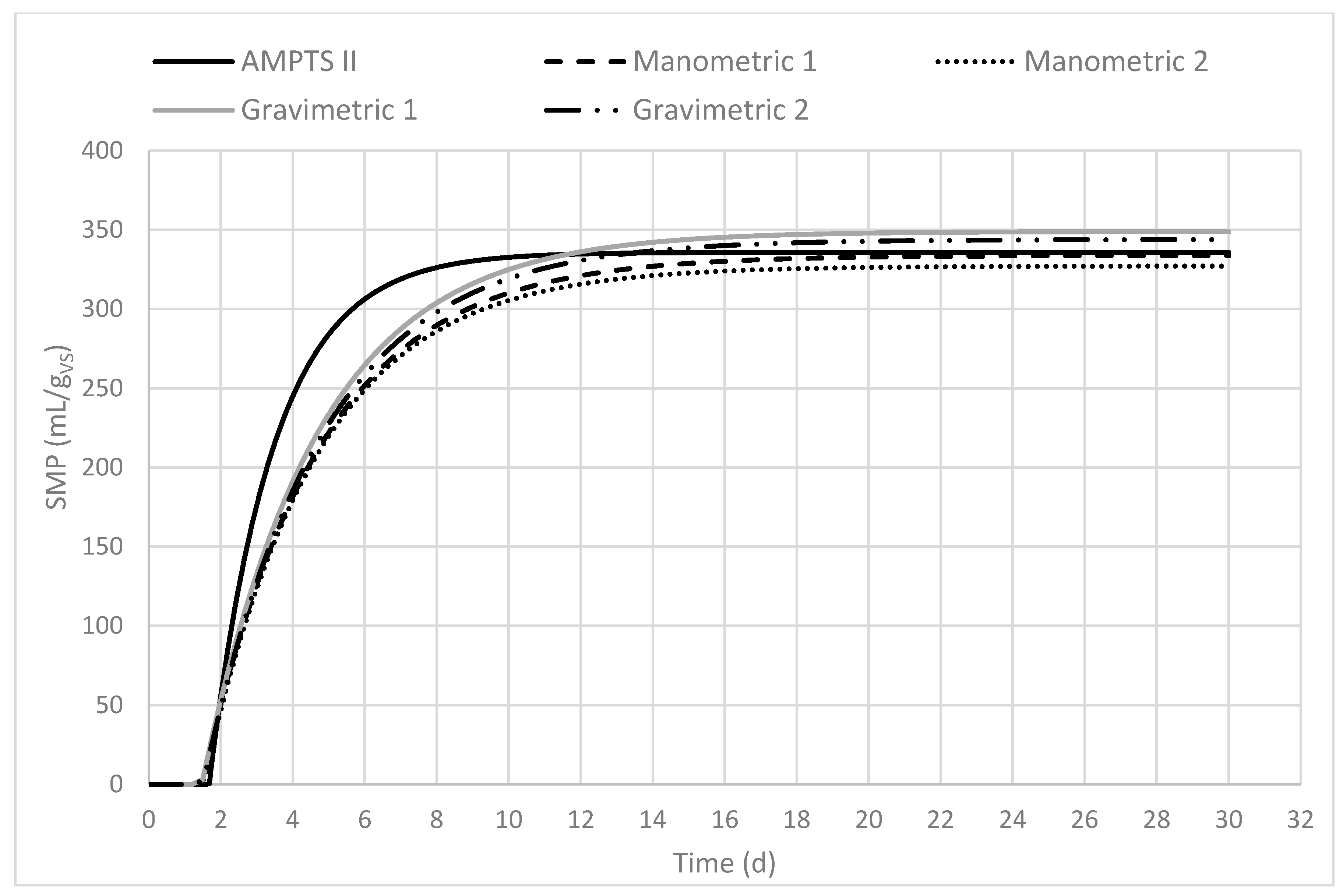
| TS (%) | VS (%) | |
|---|---|---|
| Cellulose | 93.4 ± 0.19 | 93.3 ± 0.20 |
| Inoculum | 3.13 ± 0.03 | 2.11 ± 0.04 |
| Bottle | Manometric Mixing Mode 1 | Manometric Mixing Mode 2 | Gravimetric Mixing Mode 1 | Gravimetric Mixing Mode 2 | AMPTS II | ||||||
|---|---|---|---|---|---|---|---|---|---|---|---|
| Value | Average RSD * | Value | Average RSD | Value | Average RSD | Value | Average RSD | Value | Average RSD | ||
| Inoculum | 1 | 47.5 | 48.1 1.7% | 52.5 | 52.4 2.6% | 48.5 | 49.3 2.0% | 53.0 | 53.5 1.9% | 51.3 | 55.9 7.7% |
| 2 | 49.4 | 54.3 | 50.2 | 55.1 | 59.9 | ||||||
| 3 | 48.1 | 52.9 | 49.9 | 54.0 | 56.6 | ||||||
| 4 | 47.8 | 51.2 | 48.0 | 52.8 | - | ||||||
| 5 | 47.5 | 51.0 | 49.7 | 52.8 | - | ||||||
| Cellulose | 1 | 344.5 | 343.1 1.0% | 333.3 | 330.6 2.5% | 357.9 | 357.7 1.0% | 352.8 | 347.0 2.0% | 324.9 | 342.9 7.3% |
| 2 | 344.3 | 327.9 | 358.4 | 346.1 | 334.5 | ||||||
| 3 | 344.2 | 326.6 | 361.1 | 344.1 | 369.3 | ||||||
| 4 | 338.0 | 343.1 | 353.2 | 354.1 | - | ||||||
| 5 | 344.6 | 322.0 | 357.8 | 338.0 | - | ||||||
| Bottle | Manometric Mixing Mode 1 | Manometric Mixing Mode 2 | Gravimetric Mixing Mode 1 | Gravimetric Mixing Mode 2 | AMPTS II | |||||
|---|---|---|---|---|---|---|---|---|---|---|
| Value | Average RSD | Value | Average RSD | Value | Average RSD | Value | Average RSD | Value | Average RSD | |
| 1 | 447.2 | 445.9 1.3% | 442.4 | 441.1 2.0% | 463.2 | 463.0 1.4% | 464.6 | 459.9 1.5% | 442.5 | 458.1 4.9% |
| 2 | 443.8 | 440.1 | 460.5 | 460.7 | 447.8 | |||||
| 3 | 452.4 | 432.5 | 471.7 | 452.4 | 483.8 | |||||
| 4 | 437.0 | 455.5 | 454.5 | 468.6 | ||||||
| 5 | 449.0 | 434.7 | 464.8 | 453.3 | ||||||
| Model Parameters | Manometric Mode 1 | Manometric Mode 2 | Gravimetric Mode 1 | Gravimetric Mode 2 | AMPTS II |
|---|---|---|---|---|---|
| k (d−1) | 0.31 ± 0.02 | 0.32 ± 0.02 | 0.31 ± 0.02 | 0.31 ± 0.02 | 0.56 ± 0.05 |
| B0 (mLCH4/gVS) | 333.8 ± 1.3 | 327.1 ± 5.8 | 348.9 ± 1.4 | 343.9 ± 4.5 | 335.7 ± 9.2 |
| λ (d) | 1.47 ± 0.02 | 1.52 ± 0.03 | 1.47 ± 0.02 | 1.51 ± 0.03 | 1.68 ± 0.05 |
© 2020 by the authors. Licensee MDPI, Basel, Switzerland. This article is an open access article distributed under the terms and conditions of the Creative Commons Attribution (CC BY) license (http://creativecommons.org/licenses/by/4.0/).
Share and Cite
Amodeo, C.; Hafner, S.D.; Teixeira Franco, R.; Benbelkacem, H.; Moretti, P.; Bayard, R.; Buffière, P. How Different Are Manometric, Gravimetric, and Automated Volumetric BMP Results? Water 2020, 12, 1839. https://doi.org/10.3390/w12061839
Amodeo C, Hafner SD, Teixeira Franco R, Benbelkacem H, Moretti P, Bayard R, Buffière P. How Different Are Manometric, Gravimetric, and Automated Volumetric BMP Results? Water. 2020; 12(6):1839. https://doi.org/10.3390/w12061839
Chicago/Turabian StyleAmodeo, Corrado, Sasha D. Hafner, Rúben Teixeira Franco, Hassen Benbelkacem, Paul Moretti, Rémy Bayard, and Pierre Buffière. 2020. "How Different Are Manometric, Gravimetric, and Automated Volumetric BMP Results?" Water 12, no. 6: 1839. https://doi.org/10.3390/w12061839
APA StyleAmodeo, C., Hafner, S. D., Teixeira Franco, R., Benbelkacem, H., Moretti, P., Bayard, R., & Buffière, P. (2020). How Different Are Manometric, Gravimetric, and Automated Volumetric BMP Results? Water, 12(6), 1839. https://doi.org/10.3390/w12061839







